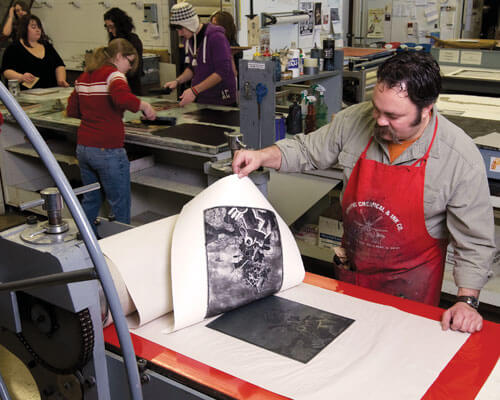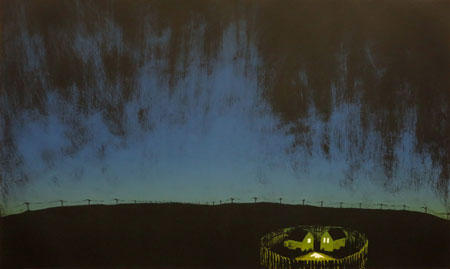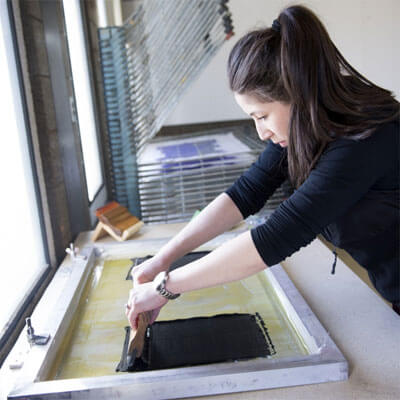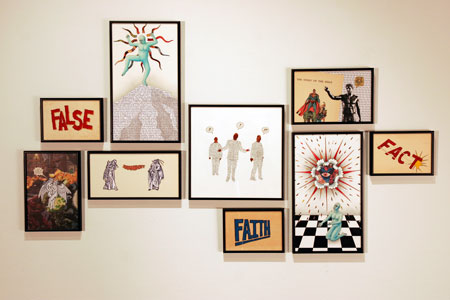A recent piece in the Huffington Post – “10 Artists, Illustrators And Designers Committed To Keeping Print Alive Around The World” – begins with the words “Print isn’t dead.”
The point of the article is, of course, to celebrate “the designers, illustrators and collectives who are still embracing the traditional corners of print techniques.”
But the sensational opening seems intended to subtly suggest the opposite – that maybe print is dying, and perhaps someone must leap to its defense as if obituaries are already being written.
Indeed, when the NIU School of Art and Design posted a link to the article on its Facebook page, one commenter left a bit of melancholy confirmation.
“I am a third generation printer,” he wrote, “but sadly I will be the last. I have printed everything from stone lithography, etching, silkscreen to web offset, but it’s all going away now.”
Michael Barnes, a professor of printmaking at NIU who has elevated his program into the nation’s Top 20 since his arrival in 1998, begs to differ.
I have been on sabbatical this year traveling to places throughout the world (France, Serbia, New Zealand and around the States), including a Fulbright Specialist Grant to conduct research on traditional print technology. I am happy to report that print is nowhere near dead anywhere in the world! In fact, the Chinese are buying up printmaking presses, lithographic stones, equipment and supplies quicker than they can make them, and setting up major facilities for the medium throughout their country.
This suggestion that print may be dying is starting to bring back memories of when everyone was saying that “Painting is Dead” back in the ’90s when I was in graduate school, which of course was not the case then, nor today.
The way I am reading this article is that they are referring to the phrase that “Print is Dead” or dying, more in the context of the newspaper or commercial publishing industry, since so much of what has traditionally been printed via offset print technology has or is moving to the Internet (also the home of the Huffington Post). They even refer to these artists as “still embracing the traditional corners of print techniques” – they are clearly coming from the angle of the commercial print industry.
This has been a big discussion within the “industry” context, especially with the developments of the Kindle and other digital book formats substituting for the “printed” word and so many of the newspaper and publication/journal subscriptions moving to digital format, not to mention all of the industry developments in the area of digital printing replacing offset. Even with that being said, I do not see “print” in the industry sense dying.
There are always going to be people who want books and hard copy publications. In the technological sense, digital inkjet printing is supplanting traditional offset lithography, but it still has not topped it in terms of quality (in my opinion). There will certainly be many transitions, but I see it as people will always want some form of “hard copy” – especially comic book collectors! I actually find the new comic books (printed via digital technology) to lack character – they are too slick and impersonal compared to the old newsprint, slightly off-register comics of past years.
I feel that this book “People of Print” (or at least the as the article portrays it, not having seen the book yet) presents the word “print” in a limited sense in respect to the larger context of the fine arts medium of printmaking – especially by calling the artists the “People of Print.”
This book is focusing on a group of artists (for the majority, but not all) who are based originally in the graphics world of illustration and design or “commercial art.” They have taken up print techniques, often through collaboration or exploration as an extension of their design based practices – especially in the medium of screen-printing and letterpress (which are both taking off like mad right now). It is part of the movement of illustrators and designers crossing over into the fine arts gallery/museum based world, which has been in high motion for a couple of decades (catapulted in part by publications such as Juxtapoz and Hi-Fructose).
I find what is going on in this movement extremely exciting as it brings a lot of the subcultures that I grew up on (comic books, punk rock/heavy metal imagery, skateboarding, graffiti/street artists, etc.) into the fine arts realms. Much of this was always call “too illustrative” or not “fine art” when I was in school, but I love it!
Print has always been at the center of “production” in this world, but the artists were often removed. Now they are getting their hands into it directly, which has opened many new creative doors for the artists and has brought a fresh new voice to the printmaking community.
In the larger sense, this idea that “print is dying” that they have alluded to (and, fortunately, rejected) brings up unnecessarily negative notions. The book is actually celebrating an aspect of what is going on around the world in the fine art medium of printmaking, which is taking off in all kinds of new and exciting directions. I think they are commendably supporting this group of artists and are intending to support the medium of printmaking, but may have a bit of tunnel vision in alluding to this suggestion that print was dying – or maybe it was to catch peoples’ attention and get them to in turn celebrate print more (that would be good).
In the grander sense of the Fine Art World, printmaking has always been somewhat of an ugly stepchild, as was photography in its early days. It is viewed by some as a reproductive process and does not produce “original” artwork. This is simply an uninformed and elitist mindset.
This kind of banter will never cease, but fortunately in the contemporary art world, print has found solid footing as the “democratic medium” it has traditionally been known as. It is also an extremely accessible medium within the context of mixed media application for the production of multiple impressions for use in installations, etc. (along with all of its traditional forms).
In the “vocational” sense, the fine arts always will involve a large amount of “do it yourself” attitude and necessity. This is where printmaking is really taking off: small shops producing prints, shirts, stickers, gig posters for bands, etc.
These are just a number of the avenues I talk to my students about as viable career options, both to support their artistic endeavors, as well as to supplement it. A career path of choice used to be toward teaching at the college level, as it would support the creative practice, while offering a community to work within through teaching, but because of the economy and major decreases in academic funding, the focus is returning to practice, which is a very good thing!
Michael Barnes will show his work this summer during “Printmakers Ball,” an exhibition scheduled from Friday, June 12, through Sept. 27 at the Rockford Art Museum. NIU School of Art and Design colleagues Aaron Coleman and Eric Fuertes also are part of the exhibition.






